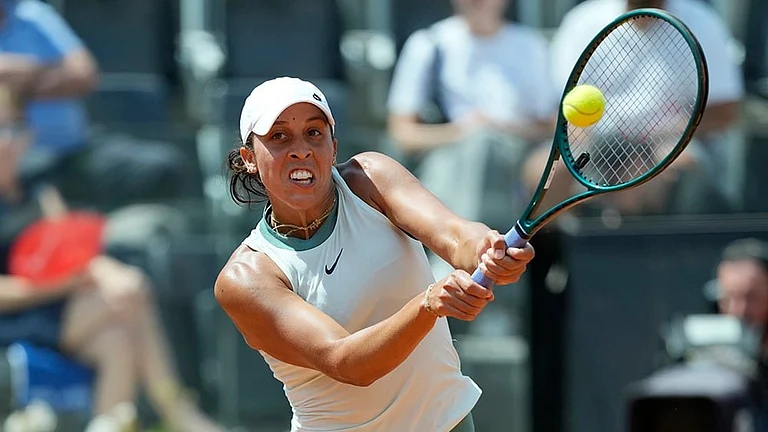"Nothing is art if it does not come from nature."
Lauded Spanish architect Antoni Gaudi's words seem to come alive on a cold winter afternoon in Lutyens' Delhi when hundreds of artworks mimicking the forces of nature descended upon the walls of the Bikaner House gallery, breathing life into its otherwise mundane crevices. Withered leaves and arterial twigs, meditating cheetahs, divine horses, and the silence of women: the vivid imagery was brought to life by the dexterous brushstrokes by the multifaceted artist Muzaffar Ali. The arcane architecture of the building in which the paintings were houses added to the juxtaposition. Amid the cold stone, Ali's artworks blazed like embers.
Held from January 11 to January 21, the ‘Mystic Journeys in Art’ was curated not as an exhibition but as an "experience" of filmmaker Muzaffar Ali’s ‘infinite possibilities as a polymath’ in the world of art, design and cinema over five decades. Curated by art critic Uma Nair, the exhibition boasts of being one of a kind and featured a melange of collage work, wood art, oil on canvas, and provocative portraits, set to the tune of an hour-long poetry session of Rumi's verses translated by Ali himself.

Beyond gifting Indian cinema with the acclaimed Rekha-starrer Umrao Jaan (1981) and other critically acclaimed films like Gaman (1978), Anjuman (1986), and more, Ali, 78, is a self-taught painter. In the words of Nair, “Muzaffar never stops drawing and painting; he is inexhaustible, almost consumed by an impulse to create”.
The artist creates, and crafts all that nature reveals to him. Ali’s 'Milestones' (2017) adorning the end of the first corridor of the gallery was a fine specimen to describe his obsession with nature. The collage installation consisted of a wooden screen divided into four folds, each topped with four oval windows, symbolizing a mythic door to a garden. A memory garden. A closer look at the circular hollows reveals dried leaves and twigs painted in colours that transported one to the artist's own little sanctuary in Kotwara estate, his ancestral royal home in Lucknow. This along with many artworks and portraits of dried autumn leaves, branches and twigs have been part of Muzaffar’s journey as an artist capturing the “secrets of nature in abstraction”.
“There is a constant itch in my hand to sketch…I feel lost all the time without my notebook and sketch pen!” Ali states about the curation.
Ali's sketchbook follows him everywhere he goes, and his prolific art was seen in almost every corner of the eight maqaams at the Bikaner House, each reminiscent of his many lives lived across Kotwara Estate, Kolkata, Delhi, Mumbai and the different lands he has travelled.

“Everything I see and feel, I want to paint. I enjoy every aspect of a medium and painting, as a medium, has great possibilities. While every medium is fraught with its own limitations, I experiment to transcend them,” says Ali, whose tryst with painting began during his adolescent years. “Today, they reflect my childlike ignorance and inquisitiveness. Yet, they stand out in my art as I celebrate the itch in my hands to draw.”
In his creations, the artist seems to tap into his knowledge of geology, botany and chemistry which plays a pivotal role in shaping his romanticism towards objects' nature, some that are easily revealed and some that require more time to be truly seen. His relationship with colours and artwork has been both organic and scientific.
The polymath also believes that science is an odyssey that runs through the beauty of the ordinary, called nature. “There’s a lot of science behind my paintings. In science, you probe a lot into the mystery of nature that reveals to you its own aesthetics and becomes a motivation to make a mystic journey. The inside and outside of a rock may make you view things differently and leaves tell you stories of cycles of time,” Ali tells Outlook.
“As a painter, I have evolved to understand the textures of life. Of time, feelings and relationship…”
A keen observer of all that's hidden around in plain sight, Muzaffar’s horses on the canvass barely show their hooves. Instead, they push one to take a pause and enjoy what nature has to offer in its synapses and absences.
In ‘Parwaaz’ (2016), four surrealistic horses, dark and sombre, tell tales of valour. While one of them ran against time, three stand still. In ‘Secrets of the Divine’ (2016), two horses face each other speaking within the silence of their space. Witnesses to the secrets of the horizons they have sped past, the two sentient beings seem to have paused to chit-chat with each other about the vagaries of speed.
The equestrian theme in many of the artworks seems to be an ode to the artist's childhood memories of Muharram, the stories of the war of Karbala, and the mourning of Prophet Muhammad. And all of it came to life in ‘Asp e Himmat’ (2021), the most ambitious of Ali's oeuvre of horse paintings. Here, the animals do not bend but look up to seek the blessings of the supreme being. Light strokes in the background hint at the vastness of space calibrated with numbers. A close-up revealed that those tiny numbers are units representing the speed of light, the scientific touches being an essential attribute of his art. The artwork seems to speak of time and space when the logic of science and divinity seem to come together.


According to Ali, “The horse is the spirit of strength who is looking up at the sky, not at a man; he wants to conquer the sky, space, and space and not a human form, who the ancient masters have transformed into icons of worship. The placement of the lights is a metaphor for Shams Tabris, a living light for Rumi".
When he paints his horses, Ali often reflects on the words of Rumi, who has set an emotive mood for most of his art. The influences were evident in the namesake 'Rumi Series' housed in another maqaam, which was a treatise in aesthetics and reminded one of the immaculate and avant-garde sets of Umrao Jaan. The elaborate ‘Awaaz-e-Ishq’ (2022) is the largest canvas of the series and decidedly the star of the show. Rumi’s poetry scribbled on the painting and narrated by Ali in Farsi in the background, contributed to the poetry and old-world sensibilities of the show, transforming it into a more wholesome "experience" as the artist had perhaps hoped.
Inspired by Rumi’s ghazals, the conceptualisation of the show and the artworks was meant to depict the journey of time in the abstract with Ali's horses directing the audience's gaze in the directions that the artist wanted.

“How and why Rumi came to me is a question I need to explore,” Ali told Nair. But each of the paintings on Rumi’s poetry is in the context “of its limitless ecstasy”. One of the most widely read poets in the world, Rumi, and Urdu poetry have for long fuelled Ali's art and imagination, driving him to unknown places where the human spirit encounters the true forces of nature.
“The four paintings in the series are depictions of Rumi’s meeting with Shams through the tapestry of time: ‘The Meeting of Rumi and Shams 1’ (2009), ‘Zikr’ (2009), ‘The Meeting of Rumi and Shams 2’ (2009), ‘Whirling’ (2009)”, Ali tells Outlook.
“Reveal thy face for
A garden in bloom I seek
Part open thy lips for
Sweetness in plenty I seek…”
(Rumi, translated by Muzaffar Ali)
From one maqaam to the other, another important motif that emerged through Ali's art was the use of triangles. “Triangle is one of the oldest geometrical shapes and in history, civilisations and eminent have been built on this structure. For Muzaffar, triangles symbolise the mystic powers of nature,” Uma Nair tells Outlook.
The grandeur of the landscape, nature, horses, and Rumi undoubtedly left the viewer stuck in an Umrao Jaan hangover. But instead of rendering them as gaudy articles of a retro parade, Ali's distinct detail to the emotionality and textures infuse his artworks with the warmth of nostalgia and convey a quiet ode to the dying artistry of Hindi cinema. This attempt to marry cinema and painting could be seen in his portraits of Umrao Jaan actress Rekha, Gaman actress Smita Patil and his wife Meera Ali which contained several cinematic allegories, feelings and climactic emotions.

In her book on Ali's art, Nair writes, “The portraits unravel as individual signatures of the fragments of Muzaffar’s emotive elegance in fashioning the few women he decides to capture for posterity.”
Through the explorations of deeply personal abstractions both within him and in nature, and by channelling an unending, childlike passion for the craft, Muzaffar Ali manages to become a mirror for his impulsive and impatient mind. From his reverence of Rumi to capturing minute and exciting details of the mundane, as Uma Nair puts it, “Muzaffar’s art odyssey of over 50 years is an inspiring story of self-reinvention".


























